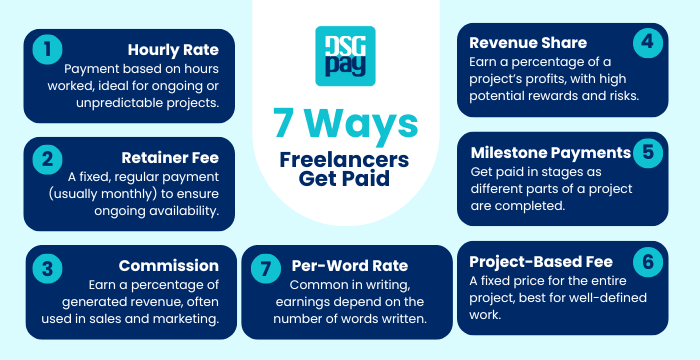Finding the best freelancer payment methods without sacrificing a significant portion of your earnings can be a challenge. With freelancers set to make up over half of the U.S. workforce by 2027, getting paid efficiently is more important than ever.
Unlike traditional employees, freelancers must choose wisely or risk delays and hidden fees. This guide breaks down the top freelancer payment methods, comparing costs, speed, and reliability to help you keep more of your hard-earned cash where it belongs in your pocket.
Table of Contents
Key Takeaways:
- Freelancer payment methods vary widely in fees, speed, and global accessibility, making it essential to choose one that fits your needs.
- Transaction fees, withdrawal costs, and currency conversion rates can significantly impact your earnings, so it’s crucial to compare these options carefully.
- Choosing a secure freelancer payment method helps protect against fraud and delays.
- A multi-currency account can help freelancers working globally by reducing conversion fees and allowing payments in multiple currencies.
How Do Freelancers Get Paid

Freelancing isn’t just about the work; it’s about choosing the right freelancer payment methods to get paid efficiently while avoiding high transaction costs. Here’s how you can charge clients and ensure a steady cash flow.
- Hourly Rate: You get paid for every hour you work. Perfect for ongoing projects or anything where the time commitment is a bit unpredictable.
- Retainer Fee: Clients pay you a regular (usually monthly) fee to keep you on standby. Reliable cash flow.
- Commission: Ideal for sales and marketing gigs. You earn a percentage of the revenue you help generate. High risk, high reward.
- Revenue Share: You take a cut of the project’s profits. If it takes off, you win big. If not well, let’s hope you picked the right client.
- Milestone Payments: You get paid in stages as you complete parts of a project. Keeps things organized and ensures you get paid along the way.
- Project-Based Fee: A fixed price for the whole job. No surprises, no guessing games, just a clear upfront agreement. Great for well-defined projects.
- Per-Word Rate: Common in writing and editing. The more you write, the more you earn.
Pick the method that works best for you, mix and match, and most importantly, always get paid what you’re worth.
The Popular Payment Methods to Get Paid as a Freelancer
Here’s a detailed breakdown of how to get paid as a freelancer, covering the most popular freelancer payment methods. Whether working with local clients or managing international payments, selecting the right method ensures fast transactions, lower fees, and secure payments.
1. PayPal
PayPal is one of the go-to freelancer payment methods, and for good reason. It’s globally accepted, easy to set up, and super simple to use. Payments typically land in your account within minutes, making it a good choice if you need quick access to your earnings. Plus, it’s trusted by clients everywhere, so it’s a win-win for both you and them.
Pros:
- Fast and secure payments.
- Accepted worldwide.
- Easy to use.
- Supports multiple currencies.
- Invoicing and payment tracking.
- Accepts credit card payments.
Cons:
- High transaction fees.
- Costly currency conversions.
- Risk of chargebacks.
- Possible account holds.
- Security risks.
- Extra fees for credit card payments.
2. Stripe
Stripe is a great option for freelancers looking for flexible and secure freelancer payment methods, especially when accepting card payments for recurring invoices. It supports credit and debit cards, bank transfers, and digital wallets like Apple Pay and Google Pay. Unlike PayPal, Stripe offers more customization, making it ideal for freelancers with their own websites.
Pros:
- Easy to set up and use.
- Supports multiple payment methods.
- Secure payment processing.
- Automates recurring payments.
- No setup or monthly fees.
- Works with international payments.
- Fraud prevention tools included.
Cons:
- Transaction fees can add up.
- Limited support for certain business types.
- Risk of account suspensions.
- Not ideal for complex billing.
- No seamless integration with other payment providers.
3. Wise
Wise (formerly TransferWise) is a budget-friendly option for freelancers who regularly work with international clients. Unlike other online payment providers, Wise gives you the mid-market exchange rate with no markup. Plus, the multi-currency account means you can hold and manage different currencies without constantly converting funds.
Pros:
- Low fees with mid-market exchange rates.
- Multi-currency account for easy international payments.
- No monthly fees.
- Free Upwork withdrawals.
Cons:
- No credit or lending options.
- Risk of account freezes.
- Limited availability in some regions.
4. Payoneer
Payoneer is a strong option for freelancers and businesses handling international transactions, particularly those using platforms like Upwork, Fiverr, and Amazon. It offers competitive rates for cross-border payments. Plus, with its prepaid Mastercard, you can spend your balance directly. However, transfers aren’t always instant, and customer support can be slow when issues arise.
Pros:
- Supports global payments, even where PayPal isn’t available.
- Multi-currency support for easier international transactions.
- Free account setup with no monthly fees.
- Low-cost transfers to other Payoneer users.
Cons:
- Charges fees for receiving and withdrawing money.
- Reports of account freeze and terminations.
- Limited customer support with slow response times.
- No payment gateway or POS system.
5. Google Pay
Google Pay is one of the freelancer payment methods that allows you to send and receive money instantly without transaction fees. Unlike other platforms that deduct a percentage from every payment, Google Pay ensures freelancers keep 100% of their earnings.
If your clients are already using Google Pay, this is one of the fastest and cheapest ways to get paid. But if they’re not, you’ll need a backup plan.
Pros:
- No transaction fees.
- Instant transfers.
- Easy to use, especially for Android users.
- Secure and backed by Google.
Cons:
- Not widely accepted by businesses.
- Only works if both parties use Google Pay.
- No international payments.
- No invoicing or business-friendly features.
6. Direct Bank Transfer
Bank transfers are among the most secure and reliable freelancer payment methods, especially for those receiving recurring payments. Domestic transfers are usually free or come with minimal fees, and since payments go directly from one bank to another, there’s no need to deal with third-party platforms.
The downside? International transfers can get pricey, especially when factoring in currency conversion fees. Processing times also vary, with some banks taking a couple of business days to complete the transaction.
Pros:
- Secure for large transactions with trusted clients.
- Simple, fast, and widely accepted by banks.
- Lower fees compared to online payment processors.
- Direct deposit eliminates the need for checks or third-party platforms.
Cons:
- No control over when the client initiates payment.
- Requires sharing bank details with clients.
- Limited visibility on payment status.
- International transfers may have fees and delays.
7. Freelance Marketplaces
Freelance marketplaces like Upwork, Fiverr and Freelancer.com provide freelancer payment methods with built-in systems that manage transactions between freelancers and clients.
These platforms ensure security, milestone-based payments, and global accessibility, making them convenient for freelancers working with international clients. However, service fees can cut into earnings, and payment processing times may cause delays.
Pros:
- Convenient, secure payments with dispute resolution.
- Automated payment processing saves time.
- Builds reputation and portfolio for more opportunities.
- Connects freelancers with a wide network of clients.
Cons:
- Marketplace fees reduce overall earnings.
- High competition makes securing projects harder.
- Some clients offer low-quality and underpaid projects.
- Limited control over client relationships.

Freelancer Payment Methods & Marketplace Fee Comparison
Selecting the right option from freelancer payment methods can help minimize fees and maximize earnings. This section compares different platforms and marketplace fees to find the best choice.
| Platform | Transaction Fees | Currency Conversion Fees | Withdrawal Fees |
| PayPal | – 2.9% + $0.30 (domestic) – 4.4% + $0.30 (international) | ~3-4% markup on exchange rates | Free (US bank) Fees for instant transfers/international |
| Payoneer | – Free (Payoneer to Payoneer) – Up to 3.99% (credit card) – 1% (ACH bank debit) – 2% (sending to bank) | – 0.5% (standard) – 3.5% (MasterCard) | – $1.50 (local bank) – 2% (international bank) – $1.95 (ATM) – $29.95 annual fee |
| Stripe | – 2.9% + $0.30 (standard) – 1.5% (intl) – 0.8% (ACH, max $5) | 1-2% if needed | Free standard withdrawals and instant payout fees apply |
| Wise | Free to receive payments in 8+ currencies, $4.14 (USD wire) | – 0.33-0.41% (varies by currency pair) – mid-market rate | – Small fixed fee – No fees for holding/using balance |
| Google Pay | – Free (P2P in the US) – Credit card fees apply | Varies by bank | – Free (bank, 1-5 days) – 1.5% (debit card, min $0.31) |
| Bank Transfer | Varies by bank | Varies by bank | – SWIFT: $25-$50 sender fee – $10-$30 intermediary fees – $25+ recipient fees – 3-5% exchange markup |
| Upwork | – 10% service fee on all earnings – 0% for Direct Contracts (Top Rated) | 2% markup | – Free (ACH US) – $0.99 (Bank) – $2 (PayPal) – $15 (Wire transfer) |
| Fiverr | 20% service fee on all earnings | Below mid-market rates | – $1 (Payoneer) – 2% (PayPal, max $1) – Direct Deposit available |
| Freelancer.com | 10% per project (fixed & hourly) | Uses its own conversion rates | – $0.99 (PayPal) – $25 (Wire transfer) – Free (Skrill) |
Choosing the Best Freelancer Payment Methods: Things to Consider
Before you commit to a payment method, think about what really matters. The wrong choice could mean hidden fees, frustrating delays, or extra hassle for your clients. Here’s what to keep in mind:
- Client Preferences Matter: Some clients swear by PayPal, while others insist on wire transfers. Stay flexible so you don’t lose work over payment logistics.
- Recurring Payments Should Be Hassle-free: If you invoice regularly, freelancer payment methods like Stripe or PayPal can save you time and headaches.
- Currency Conversion Fees Add Up Fast: If you work with international clients, compare platforms to avoid losing money on terrible exchange rates.
- Make Invoicing Easier: If you’re using FreshBooks or QuickBooks, pick a payment method that syncs up to keep everything neat and organized.
- Transaction Fees Can Eat Into Your Earnings: Some freelancer payment methods take a percentage of every payment. Look for options with low fees or none at all.
- Speed Matters: Some methods payout instantly, while others leave you waiting for days (or even weeks). If cash flow is a concern, don’t ignore this.
- Go Global Without Losing Money: If you work with international clients, pick a method that supports multiple currencies without charging ridiculous fees.
- Ease of Use is Key: If your payment method is a nightmare to set up or forces clients to jump through hoops, you’ll spend more time chasing payments than getting paid.
The best payment method is the one that gets you paid quickly, with minimal hassle, and without imposing hidden or excessive fees that significantly reduce your earnings.
Tips for Getting Paid as a Freelancer
- Send invoices that leave no room for excuses. Be clear, professional, and detailed about what you did. The sooner you send it, the sooner you get paid.
- Contracts aren’t just for big deals. Lock in payment terms, deadlines, and late fees upfront so clients can’t pull the old “Oh, I forgot” routine.
- Chase payments without actually chasing. Set up automatic reminders for overdue invoices and let the system do the nagging for you.
- Give clients options, but not too many. Offering multiple freelancer payment methods makes it easier for them to pay. Just don’t overwhelm them with choices.
- Protect yourself, especially with new clients. Use escrow services like Upwork’s system or trusted third-party platforms for high-value projects so you don’t end up working for free. Choosing secure freelancer payment methods also helps prevent fraud and delayed payments.
Final Thoughts
When choosing freelancer payment methods, the goal is to get paid fast, securely, and with minimal fees. PayPal is convenient but comes with higher costs, while Wise offers lower fees for international transfers. Stripe is great for handling card payments, and direct bank transfers work well for larger amounts.
The best freelancer payment methods are the ones that match your priorities; speed, low fees, or global accessibility. Choose wisely to maximize your earnings and minimize unnecessary fees.
How DSGPay Makes Getting Paid Faster and Easier for Freelancers
When transferring funds to local bank accounts in countries like South Korea, Singapore, Indonesia, India, the Philippines, Hong Kong, Australia, or New Zealand, or in regions such as the UK, EU, and USA.
While platforms like PayPal and Wise are widely used, DSGPay offers an alternative that supports multi-currency accounts, global access, and flexible withdrawal options, making it easier to stay in control of your income.
- Global Virtual Accounts: Get a multi-currency virtual account in your name or business name for seamless and professional transactions.
- Hold and Convert Over 30 Currencies: Manage payments in USD, GBP, EUR, HKD, SGD, and more, avoiding losses from poor exchange rates.
- Flexible Withdrawal Options: Withdraw your earnings via ACH, wire transfer or other supported payout methods without needing a U.S. or local bank account.
- Transparent, Low-Cost Transactions: No hidden fees, just fair rates to ensure you keep more of your earnings.
- Faster and Cheaper Transactions: Reduce waiting times and transaction costs compared to traditional international transfers.
- Real-time Tracking: Track transactions in real-time, and get instant updates, so you always know where your money is.
- Regulatory Compliance and Security: Ensures all transactions are secure and meet legal requirements.
With DSGPay, freelancers can focus on their work without worrying about payment delays, high fees, or currency conversion losses. Whether you’re handling local clients or international transactions, DSGPay ensures that your earnings are processed quickly, securely, and at a fair cost.
Ready to simplify your freelance payments?



